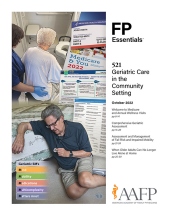
This clinical content conforms to AAFP criteria for CME.
Older adults living alone at home are at risk of many adverse outcomes, including injuries from falls, firearms, and driving; adverse drug events due to drug errors; and self-neglect or elder abuse. An estimated 4.5 million Medicare beneficiaries became homebound between 2012 and 2018. Becoming homebound increases the risk of harm for older adults. Clinicians should evaluate the home safety of older adult patients, which requires assessing their medical conditions, home physical environment, and social circumstances. Identified problems should be addressed with interventions that allow patients to live safely in the least restrictive environment possible. The least restrictive interventions are in-home modifications (eg, installation of handrails and grab bars) and use of remote monitoring, in-home services, and shopping and transportation services. Daytime participation in senior centers or adult day care also can be useful. Some patients will require a change in living situation, with a move to senior housing or retirement communities, group homes, assisted living communities, skilled nursing facilities, or the home of a family member. Some of these alternative living situations require financial resources that a patient or family members may not have. Public assistance is available in some cases, if patients meet eligibility requirements.
Case 4. BG is an 83-year-old woman whose husband died of cancer 4 years ago. She has been living alone since then. Her conditions include diabetes with peripheral neuropathy and mild depression. In the past 3 years, BG has been hospitalized three times. Two of the hospitalizations were because of falls and hyperglycemia. Her adult daughter MG contacts you and is concerned about whether it is safe for BG to be living at home alone.
Subscribe
From $350- Immediate, unlimited access to FP Essentials content
- 60 CME credits/year
- AAFP app access
- Print delivery available
Edition Access
$44- Immediate, unlimited access to this edition's content
- 5 CME credits
- AAFP app access
- Print delivery available
